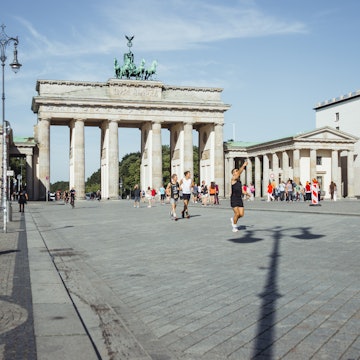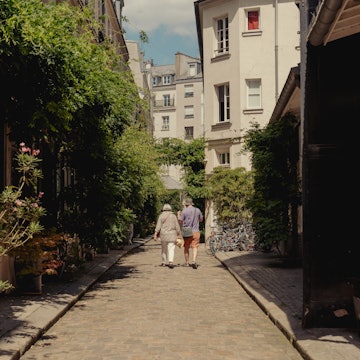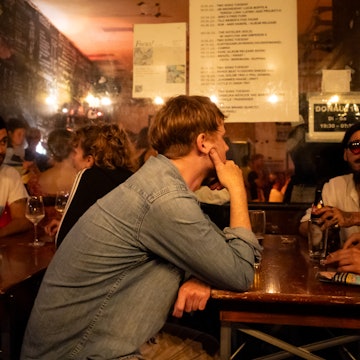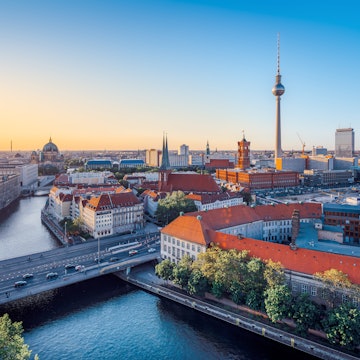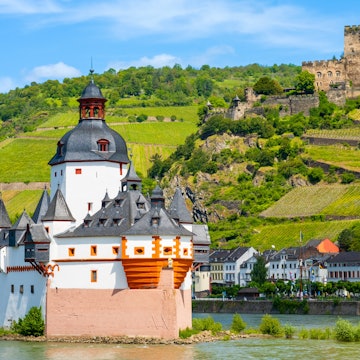

A U-Bahn crossing Oberbaumbrücke in Berlin. Nikada/Getty Images
From the beloved yellow subways to the highly efficient short-distance and regional trains, and the panoramic double-decker buses, Berlin's public transit system is a well-choreographed symphony of movement. In addition to this, e-scooters, bike rentals, and car-sharing options are all perfectly complemented by green and beautiful walking areas. Plan your travels around Berlin with this guide to public transportation.
Ride the U-Bahn
With subways running every 5–10 minutes during the day, and every 15–20 minutes until late (to 1am on weekdays and all night at weekends), the Berliner U-Bahn is a symbol of the city and by far the best way to get around. Easy to catch almost everywhere you are, this network of 9 different lines, 175 stations and 155km of track reaches almost every corner of the city. Locals love it for its efficiency, connectivity and frequency, while visitors find it the most comfortable way to explore without having to plan too much.
The U1, U3 and U2 lines are good for east–west connections, while the U8 is the favorite for partygoers at night. The "cultural line," U5, is ideal for travelers seeking to explore Berlin's prominent attractions. Starting from Berlin's main station (Hauptbahnhof) and extending eastward to Honow, passengers can conveniently hop on and off at key landmarks such as the Reichstag, the Brandenburger Tor, the Museumsinsel, and Alexanderplatz. This is particularly ideal for those rainy Berlin days when you want to explore the city's cultural gems without much hassle.

Reach Berlin's outskirts on the S-Bahn
Even though it is less frequent and not as well connected as the U-Bahn, the S-Bahn remains the preferred choice for travelers seeking to cover longer distances or venture to the outskirts of Berlin. With 15 lines operating on elevated and underground tracks, the S-Bahn offers the fastest way to traverse from east to west and north to south. Like the U-Bahn, most lines run to 1am on weekdays and at 30-minute intervals overnight at weekends.
Take the Ring line to reach different neighborhoods without going through the busy center, or take one of the connecting trains between Zoologischer Garten and Ostbahnhof to get some glimpses of Berlin’s bustling urban scene from above ground.
The S-Bahn is particularly convenient for day trips to destinations located just outside Berlin. It provides easy access to the cozy and historical district of Spandau, the neighboring city of Potsdam, and the beautiful lakes of Wannsee, Müggelsee and Schlachtensee.
Take buses and trams to more remote parts of the city
Although they are known for being slow and sometimes unreliable (of course, only by German standards!), buses and city trams not only take you to the most remote parts of the city, but also offer a different view of Berlin.
While trams mostly run in the former East Berlin, buses reach every single corner of the city with their massive network of around 200 lines. Even though they are not as efficient as the U-Bahn due to traffic at peak times, some buses (M11 to M85) and trams (marked with an “M”) run 24/7 and won’t let you down.
Tip for seeing Berlin's key spots on a budget: Take either the 100 or 200 double-decker bus. They pass through Berlin’s most famous landmarks. If you are quick getting on at the first stop, Alexanderplatz, you might get a front window spot on the upper floor, giving you a city bus tour for just a few euro.

Hire an e-scooter for short distances
Love them or hate them, e-scooters can be incredibly convenient for getting around Berlin. These small, user-friendly vehicles are practical and fun, making them a great transportation option for short distances and sightseeing.
E-scooters are stationed almost everywhere in the city, and they can be used on the extensive cycling paths. There are four companies – Lime, Dott, Voi, and Bolt – and some charge a flat fee to unlock the scooter, plus a fee per minute of riding; others charge a monthly subscription fee, which gives you unlimited rides.
Use a car-share app
Just like in any other metropolis around the world, driving a car can sometimes be a nightmare. There are times, though, when having your own vehicle is the most convenient way to get around. Car-sharing companies are very popular among locals in Berlin, and almost everywhere within the city limits you can use an app to rent a car in seconds. You then pay for the distance driven.
The most popular car-sharing companies in the city are Free2Move and Miles. When you sign up, you will need to submit your driving license and verify your identity, so be sure to plan ahead.
At night, it's best to take a taxi
Berliners rarely use private transportation to move around the city, but at night, it is a safer option. Apps like Uber, Freenow or Bolt offer their services all over the city, and even tend to be slightly cheaper than the traditional taxi cabs.
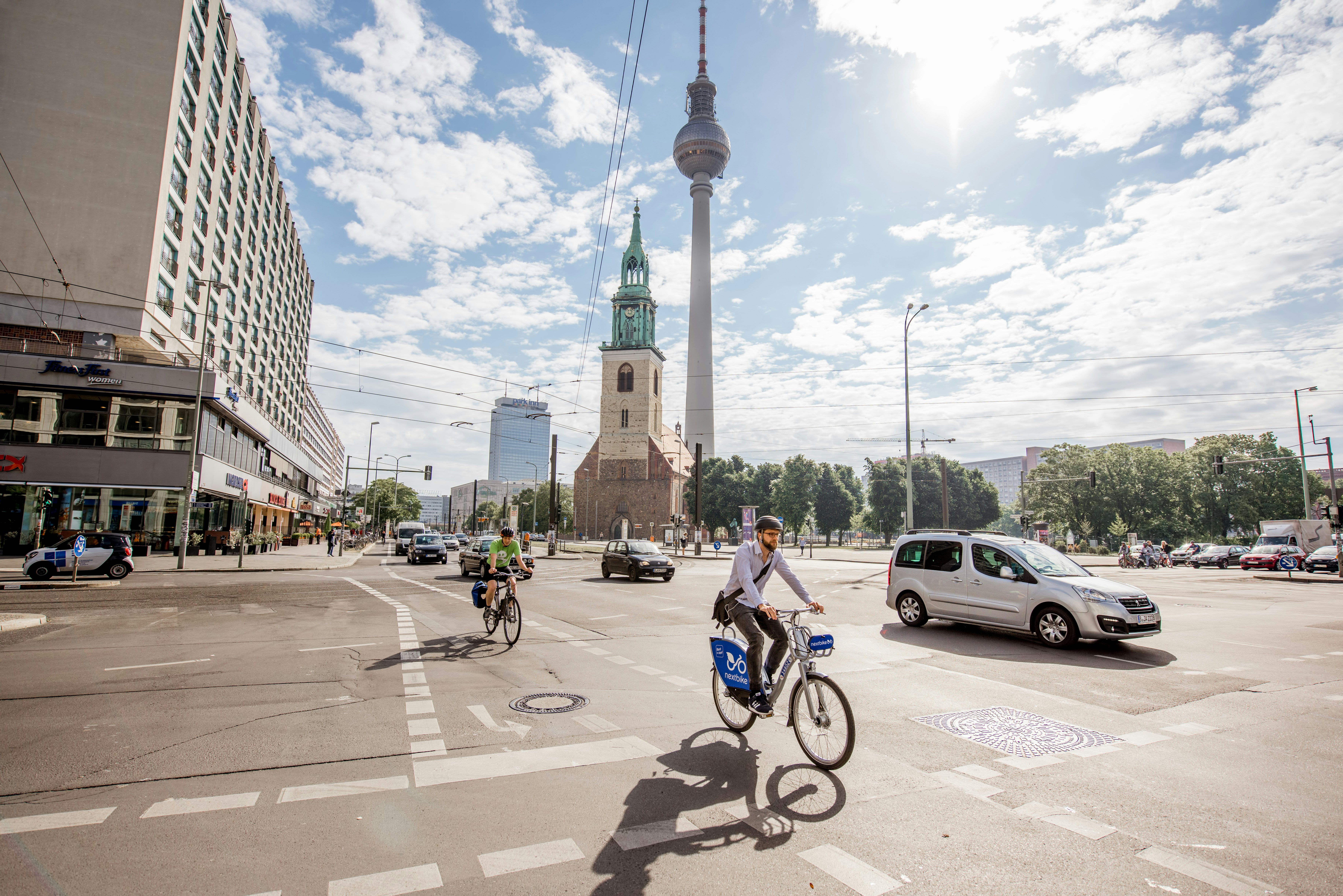
Explore Berlin at your own pace on a bike
Cycling in the city center is cheap, environmentally friendly and, in many cases, faster than any other form of transportation. With over 620km of cycling paths all over the city, on a typical day you will see both commuting locals and visitors exploring the city by bike.
Although renting a bicycle for a day is very easy at hostels, hotels and rental shops, bike or e-bike sharing is probably the best option when balancing cost and flexibility. Berlin's most popular bike-sharing apps include Dott, NextBike, Lime and Bolt.
Wander through the city on foot
Berlin is a city designed to be explored on foot. Large avenues connect to beautiful squares, there are parks almost everywhere, and pedestrian-only areas lead to charming alleys. There's nothing quite like simply strolling along and getting lost – an exploration that often leads to discovering a new favorite cafe or a unique boutique.
However, if you are keen on walking tours, the tip-based "free walking tours" from GuruWalk and Sandeman's New Europe are always a good choice, especially for first-timers. For seasoned travelers in Berlin, a private city tour from Airbnb Experiences or Get Your Guide can provide a more personalized experience.
Transport passes and travel zones
The public transportation system comprises fare zones A, B and C. Zone A includes the city center of Berlin and the S-Bahn-Ring, zone B begins outside the S-Bahn ring and reaches Berlin’s city limits, and zone C includes the outskirts, BER airport, and the city of Potsdam. Each ticket is valid for all forms of public transport, and tickets are available for zones AB (€3.80), BC (€4.30) or ABC (€4.70).
For first-time travelers visiting Berlin, the AB zone is more than sufficient, as most tourist attractions are located within its boundaries. If you arrive from the airport or plan to explore Potsdam on a particular day, consider getting the ABC ticket for broader coverage.
Single tickets remain valid for 120 minutes from the moment of purchase. Validate tickets bought from vending machines by stamping them at the station platforms. However, tickets purchased through the BVG app or on trams and buses do not require additional validation. Passes can offer good value for money and flexibility, offering unlimited travel within the selected zones. If you are planning to stay longer than 7 days in Germany, purchasing a Deutschlandticket can be a great alternative to maximize your use of the country's public transport system and save money.
With no ticket barriers and only a few inspectors, travelers can get the impression that public transport in Berlin is free. However, if you ever get caught traveling without a ticket, you will receive a fine of €60. More information about fares, network maps and ticket options is available at the BVG official website.










